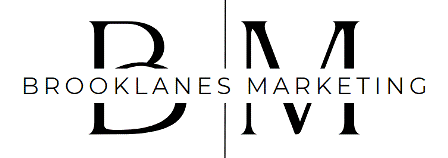brooklanes marketing
online brand marketing
making an impact
online store brand id
Marketing your brand online is essential in today’s digital age, as it allows you to reach a vast audience, engage with potential customers, and build a strong online presence. Here are some key steps and strategies to effectively market your brand online:
Define Your Brand Identity: Before you start marketing online, it’s crucial to have a clear understanding of your brand identity, including your values, mission, and target audience. Your brand identity will inform your online marketing strategy.
Create a Professional Website: Your website is often the first point of contact with potential customers. Ensure it is visually appealing, user-friendly, and provides essential information about your brand, products, and services.
Optimize for Search Engines (SEO): Implement SEO techniques to improve your website’s visibility on search engines like Google. This involves using relevant keywords, creating quality content, and optimizing on-page elements.
Content Marketing: Develop a content marketing strategy that includes creating valuable and relevant content such as blog posts, articles, videos, and infographics. This content can help you establish authority in your industry and attract organic traffic.
Social Media Marketing: Choose the social media platforms that align with your target audience and industry. Create and share engaging content, interact with followers, and use paid advertising to increase your reach.
Email Marketing: Build and maintain an email list of interested customers. Use email marketing campaigns to share updates, promotions, and valuable content with your subscribers.
Pay-Per-Click (PPC) Advertising: Use platforms like Google Ads or social media advertising to run targeted ad campaigns. PPC can be an effective way to reach potential customers quickly.
Influencer Marketing: Collaborate with influencers in your niche to promote your products or services. Influencers can help you tap into their established audiences and build credibility.

9. Online Reputation Management: Monitor and manage your brand’s online reputation. Respond to reviews, both positive and negative, on platforms like Google, Yelp, and social media.
10. Analytics and Tracking: Use analytics tools like Google Analytics to monitor the performance of your online marketing efforts. Analyze data to make informed decisions and refine your strategy over time.
11. Mobile Optimization: Ensure your website and marketing materials are mobile-friendly, as many users access the internet via smartphones and tablets.
12. Video Marketing: Create video content for platforms like YouTube, Instagram, and TikTok. Video can be a highly engaging and shareable format.
13. Community Building: Engage with online communities related to your industry or niche. Participate in discussions, answer questions, and provide value to establish your brand as an authority.
14. Online Advertising: Consider display advertising on relevant websites or industry-specific forums to increase brand visibility.
15. Remarketing: Use remarketing techniques to target users who have previously visited your website but did not make a purchase. This can help re-engage potential customers.
16. Local SEO: If you have a physical location, optimize your online presence for local search to attract customers in your area.
17. A/B Testing: Continuously test different elements of your online marketing campaigns, such as ad copy, landing pages, and email subject lines, to optimize for better results.
18. Customer Engagement: Foster relationships with your customers through online engagement, customer support, and personalized communication.

Product and services branding are essential components of a company’s overall marketing strategy.
They involve creating a unique and recognizable identity for the products and services a company offers to its customers.
Effective branding can help a business stand out in the market, build trust with consumers, and ultimately drive sales and loyalty.
Here are some key aspects of product and services branding:
some key points to consider IN brand marketing
Brand Identity: This includes the visual elements that represent a brand, such as logos, color schemes, typography, and design elements. Consistency in these elements across all marketing materials and touch-points helps create a strong brand identity.
Brand Positioning: This involves defining how you want your products or services to be perceived in the market. Are you offering high-end, luxury items, or affordable and practical solutions? Your positioning should align with your target audience’s needs and preferences.
Brand Messaging: Develop a clear and compelling message that communicates the unique value your products or services offer. This message should resonate with your target audience and differentiate your brand from competitors.
Target Audience: Identify and understand your target audience’s demographics, psychographics, and pain points. Tailor your branding efforts to appeal to this specific group of consumers.
Brand Promise: Your brand should make a promise to customers about what they can expect when they choose your products or services. This promise should be consistently delivered across all interactions with your brand.
Brand Experience: The overall experience customers have with your brand, from browsing your website to using your products or services, plays a crucial role in branding. Ensure that this experience aligns with your brand identity and promise.
Brand Consistency: Consistency is key in branding. Make sure that your branding elements, messaging, and values are consistent across all channels, including your website, social media, packaging, and customer service.
Brand Awareness: Build awareness of your brand through marketing efforts such as advertising, content marketing, social media, and public relations. The goal is to make your brand easily recognizable and memorable.
Brand Loyalty: A strong brand can foster loyalty among customers. This loyalty can lead to repeat business and advocacy, as satisfied customers are more likely to recommend your products or services to others.
Brand Evolution: Over time, brands may need to evolve to stay relevant and meet changing consumer needs. However, any changes should be carefully considered to avoid alienating existing customers.
Measuring Brand Success: Use key performance indicators (KPIs) to measure the success of your branding efforts. This may include metrics like brand awareness, customer satisfaction, and revenue growth.
Brand Protection: Trademarks and intellectual property rights are important for protecting your brand from imitators and counterfeit products.
In summary, product and services branding involves creating a distinct and consistent identity for what you offer in the market. A strong brand can help attract and retain customers, build trust, and drive business growth. It requires a strategic approach that considers every aspect of how your brand is perceived by your target audience.
benefits to consider IN branding
Brand benefits refer to the advantages and positive attributes associated with a well-established and recognized brand. These benefits can contribute to a brand’s success and customer loyalty. Here are some common brand benefits:
Recognition and Trust: Established brands are easily recognizable, and consumers often associate them with quality and reliability. This recognition and trust can lead to higher sales and customer loyalty.
Quality Assurance: Brands that have a reputation for quality can charge premium prices for their products or services. Customers are willing to pay more for the assurance of getting a high-quality product.
Consistency: Established brands often maintain a consistent level of quality and customer experience across their products or services. This consistency helps build trust and reliability.
Customer Loyalty: Brands that consistently deliver value and quality tend to have more loyal customers. These customers are more likely to repeat purchases and recommend the brand to others.
Perceived Value: A strong brand can enhance the perceived value of a product or service. Customers may believe that a branded product is superior to unbranded or generic alternatives, even if the actual features are similar.
Competitive Advantage: Well-known brands often have a competitive advantage in the market. They may have a larger market share, better distribution channels, and more resources for marketing and innovation.
Emotional Connection: Brands can evoke emotional connections with customers. People may feel a sense of belonging, nostalgia, or even loyalty to a brand, which can lead to repeat business.
Brand Loyalty: Customers who identify with a brand’s values and image are more likely to become brand loyalists. This can lead to long-term customer relationships and ongoing revenue.
Price Premium: Brands that have a strong reputation can command higher prices for their products or services. Customers may be willing to pay extra for the perceived quality and trust associated with the brand.
Marketing Efficiency: Established brands often spend less on marketing and advertising because they already have name recognition. This can lead to cost savings and higher profit margins.
Expansion Opportunities: Successful brands can more easily expand into new markets or product categories because they already have a built-in customer base and trust.
Risk Mitigation: Established brands can weather market fluctuations and crises more effectively than lesser-known brands because they have a loyal customer base and resources to adapt.
Partnerships and Alliances: Strong brands can form strategic partnerships and alliances with other companies, further expanding their reach and influence.
Attracting Talent: Recognizable brands can attract top talent, making it easier to recruit skilled employees who want to be associated with a reputable company.
Social Responsibility: Brands with a positive image can use their influence to promote social and environmental responsibility, which can attract socially conscious consumers.
It’s important to note that brand benefits are not automatic; they require consistent effort in maintaining and enhancing a brand’s reputation. Brands must also adapt to changing consumer preferences and market dynamics to continue reaping these benefits.

Effective online branding
online branding by design
Effective online branding is essential for businesses and individuals looking to establish a strong presence on the internet
ONLINE RETAIL startup
Marketing is a crucial aspect of launching and growing an online retail startup. Here are some strategies and tips to help you effectively market your online retail business. Understand Your Target Audience !!
usb branding
After identifying your target audience and gained an insight into their needs and preferences, as well as crafting a compelling Unique Selling Proposition (USP), you'll establish a robust, coherent, and unforgettable brand identity.
Online brand marketing
After identifying your target audience and gained an insight into their needs and preferences, as well as crafting a compelling Unique Selling Proposition (USP), you'll establish a robust, coherent, and unforgettable brand identity.
Back to our home page
Marketing is a crucial aspect of launching and growing an online retail startup. In this site we have outlined some strategies and tips to help you effectively market your online retail business.
contact us if interested
Please send us your inquiry, if you need a viable synergy development between website design and your brand marketing. Simply fill out our free consultation contact form.
COPYRIGHT BROOKLANES MARKETING 2023 [ DANI MERAD DESIGNS ]
